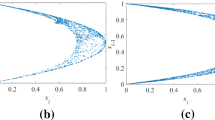Abstract
The paper proposes a novel algorithm to get the encryption matrix. Firstly, a chaotic sequence generated by Chebyshev chaotic neural networks is converted into a series of low-order integer matrices from which available encryption matrices are selected. Then, a higher order encryption matrix relating real world application is constructed by means of tensor production method based on selected encryption matrices. The results show that the proposed algorithm can produce a “one-time pad cipher” encryption matrix with high security; and the encryption results have good chaos and autocorrelation with the natural frequency of the plaintext being hidden and homogenized.
Similar content being viewed by others
References
Tan Guolv. A kind of data encryption scheme based on the tensor product of matrices. Computer Science, 29(2002)8, 119–120, 125 (in Chinese). 谭国律. 基于矩阵张量积的数据加密方案. 计算机科学, 29(2002)8, 119–120, 125.
Bibhudendra Acharya, Sarat Kumar Patra, and Ganapati Panda. Involutory, permuted and reiterative key matrix generation methods for Hill cipher system. International Journal of Recent Trends in Engineering, 1(2009)4, 106–108.
Xu Jingshi and Tan Li. Methods of matrix encryption and decryption. Journal of Changsha University of Electric Power (Natural Science), 18(2003)1, 1–3 (in Chinese). 徐景实, 谭利. 矩阵加密与解密的一些方法. 长沙电力学院学报(自然科学版), 18(2003)1, 1–3.
Xu Junyi, Sun Wei, and Qi Dongxu. Kronecker products and applications. Journal of Computer-Aided Design & Computer Graphics, 15(2003)4, 377–388 (in Chinese). 许君一, 孙伟, 齐东旭. 矩阵Kronecker乘积及其应用. 计算机辅助设计与图形学学报, 15(2003)4, 377–388.
Charles F. Van Loan. The ubiquitous Kronecker product. Journal of Computational and Applied Mathematics, 123(2000)1/2, 85–100.
Song Caiqin and Zhao Jianli. Application of permute matrix in the commutation of tensor products of matrices. Journal of University of Jinan (Natural Science), 23(2009)2, 218–220 (in Chinese). 宋彩芹, 赵建立. 换位矩阵在矩阵张量积交换中的应用. 济南大学学报(自然科学版), 23(2009)2, 218–220.
Tan Guolv. Construction of the encryption matrix based on matrices tensor production. Computer Project and Application, 42(2006)23, 64–65 (in Chinese). 谭国律. 基于矩阵张量积的数据加密矩阵的构造. 计算机工程与应用, 42(2006)23, 64–65.
Zou Ajin and Xiao Xiuchun. Asynchronous encryption of neural networks based on chaotic control system. Computer Engineering, 34(2008)12, 160–161 (in Chinese). 邹阿金, 肖秀春. 基于混沌控制系统的神经网络异步加密算法. 计算机工程, 34(2008)12, 160–161.
Zou Ajin and Zhang Yunong. Basis Function Neural Network and Its Application. Guangzhou, Sun Yat-Sen University Press, China, 2009: 24–26 (in Chinese). 邹阿金, 张雨浓. 基函数神经网络及应用. 广州, 中山大学出版社, 2009, 24–26.
Tiegang Gao and Zengqiang Chen. A new image encryption algorithm based on hyper-chaos. Physics Letters A, 372(2008)4, 394–400.
H. J. Gao, Y. S. Zhang, S. Y. Liang, et al.. A new chaotic algorithm for image encryption. Chaos Solitons and Fractals, 29(2006)2, 393–399.
Deng Shaojiang, Huang Guichao, Chen Zhiiian, et al.. Self-adaptive image encryption algorithm based on chaotic map. Journal of Computer Applications, 31(2011)6, 1502–1504, 1511 (in Chinese). 邓绍江, 黄桂超, 陈志建, 等. 基于混沌映射的自适应图像加密算法. 计算机应用, 31(2011)6, 1502–1504, 1511.
Chi Chunjian, Yu Wanbo, and Wei Xiaopeng. Image encryption based on function expansion and hyperchaotic system. Computer Engineering, 37(2011)8, 146–152 (in Chinese). 迟春见, 于万波, 魏小鹛. 基于函数展开与超混沌系统的图像加密. 计算机工程, 37(2011)8, 146–152.
Hu Chunqiang, Deng Shacrjiang, Qin Mingfu, et al.. Image encryption algorithm based on logistic and standard map. Computer Science, 37(2010)12, 57–59 (in Chinese). 胡春强, 邓绍江, 秦明甫, 等. 基于与标准映射的数字图像加密算法. 计算机科学, 37(2010)12, 57–59.
Lu Huibin and Sun Yan. Image encryption scheme based on novel hyperchaotic system. Computer Science, 38(2011)6, 149–152 (in Chinese). 卢辉斌, 孙艳. 基于新的超混沌系统的图像加密方案. 计算机科学, 38(2011)6, 149–152.
F. M. Ham and I. Kostanic. (Ye Shiwei and Wang Haijuan). Principles of Neurocomputing for Science & Engineering. Beijing, China Machine Press, 2007, 434 (in Chinese). F. M. Ham and Ivica Kostanic. (叶世伟, 王海娟译). 神经计算原理. 北京, 机械工业出版社, 2007, 434.
Author information
Authors and Affiliations
Corresponding author
Additional information
Supported by the National Natural Science Foundation of China (No. 61173036).
Communication author: Li Yongjiang, born in 1967, male, Ph.D., Associate Professor.
About this article
Cite this article
Zou, A., Wu, W., Li, R. et al. Construction of the encryption matrix based on Chebyshev chaotic neural networks. J. Electron.(China) 29, 248–253 (2012). https://doi.org/10.1007/s11767-012-0796-9
Received:
Revised:
Published:
Issue Date:
DOI: https://doi.org/10.1007/s11767-012-0796-9




